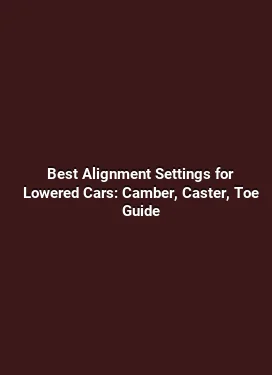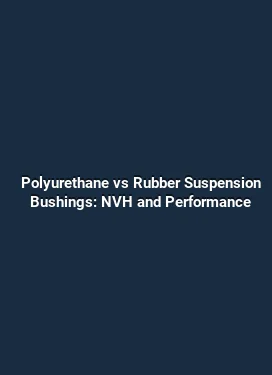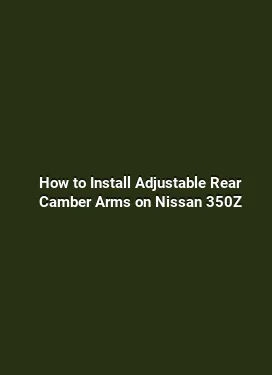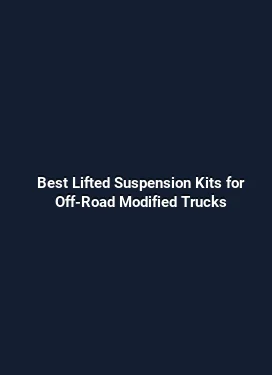K-Sport vs Tein Coilovers for JDM Cars: A Comprehensive Quality and Handling Comparison
Understanding Coilover Design and Why It Impacts Handling

The coilover system sits at the intersection of ride quality and performance, translating road texture into tire contact with the pavement. For JDM cars, where chassis tuning and balance are part of the culture, the coilover selection influences how the suspension responds to cornering, braking, and road irregularities. In essence, coilovers determine how much control a driver has over the wheel trajectory and how predictable the car feels when pushed at the limit.
Two foundational elements shape coilover performance: damping characteristics and spring rate. Damping, which controls rebound and compression, determines how quickly the suspension settles after a bump or a turn. Spring rates influence how the chassis responds to weight transfer during acceleration, braking, and cornering. The interplay between dampers and springs defines the overall ride height, ride quality, body roll, and tire contact patch in dynamic driving scenarios. Modern coilovers often feature adjustable damping and ride height, and some models allow camber or toe adjustments via mounting options or top-mount choices. These adjustments enable refinement of steering feel, turn-in response, and overall track or street performance.
Key Attributes of High-Quality Coilovers

Durability and consistent performance over time are essential. Quality coilovers typically exhibit robust materials, precise machining, and reliable seals to withstand environmental factors such as temperature fluctuations and road salt. A well-engineered unit also offers predictable damping across a range of temperatures, ensuring that performance does not fluctuate with weather. Consistency between left and right sides is another hallmark, enabling symmetrical handling and balanced load distribution during aggressive driving.
K-Sport vs Tein: Build Quality, Damping, and Adjustability
When evaluating coilovers for JDM applications, three pillars stand out: build quality, damping performance, and adjustability. Both K-Sport and Tein have established reputations in the import tuning community, yet they approach these pillars with distinct philosophies. This section dissects material choices, damping mechanisms, and the practical implications for street and track use, emphasizing real-world scenarios rather than theoretical specs alone.
Materials, Seals, and Overall Durability
K-Sport coilovers are often built around strong forged or machined components with corrosion-resistant finishes, designed to maintain stiffness and precision under harsh driving conditions. The attention to sealing quality is critical for longevity, particularly in climates with moisture and road salt. Tein coilovers emphasize a balance between alloy rigidity and weight, frequently leveraging coatings that resist corrosion and reduce drag as the suspension cycles through its range. In practice, both brands aim to deliver units that maintain alignment and repeatability after thousands of cycles. For JDM cars, where weekend tuning sessions and track days are common, durability translates to fewer trips to the shop and more time on the road or circuit.
Beyond raw materials, the assembly tolerances play a role in noise, vibration, and harshness (NVH). A well-fitted monotube design, used by several Tein and K-Sport lines, reduces internal fluid cavitation and improves damping consistency. NVH levels matter to enthusiasts who spend long hours behind the wheel, yet the focus remains on achieving predictable control rather than a completely silent ride.
Damping Characteristics: How They Translate to Real-World Handling
Damper architecture—whether monotube or twin-tube—affects how quickly the suspension responds to road input. Monotube dampers generally offer better heat dissipation and more linear damping curves, which is beneficial on spirited drives and track sessions. Twin-tube designs can deliver a softer initial response, contributing to a more comfortable street ride. In practical terms, a coilover set with adjustable damping enables you to tailor the steering response and body control across a range of speeds and road surfaces. For JDM enthusiasts, this means the ability to dial in sharper turn-in for canyon runs while preserving a compliant ride on everyday roads.
K-Sport systems often emphasize aggressive damping tuning that suits performance-oriented applications. Tein products tend to provide a broader spectrum of adjustability with a focus on predictable feedback and linear response. The choice between these approaches depends on the intended driving context—daily commuting versus occasional track days—and how much time a driver spends on fine-tuning the setup.
Adjustability: Height, Damping, and Alignment Tuning
Height adjustment lets you lower the vehicle to reduce center of gravity and improve aero efficiency, while also affecting suspension geometry. Damping adjustment enables fine control over how quickly the damper compresses and rebounds, which directly impacts roll stiffness and tire contact during cornering. Alignment adjustments, including camber and toe, further refine steering feel and tire wear characteristics. In the JDM scene, many owners adopt a stance that emphasizes visual appeal alongside performance, making easy and reliable adjustability a key criterion.
From a practical standpoint, it’s important to consider how easy the adjustment process is in daily life. Some coilovers permit on-car adjustments for damping and ride height, allowing quick changes without dismantling the wheel assembly. Others require more involved procedures or tool-heavy steps. For the average enthusiast, a system that preserves repeatable settings after road use and weather changes is valuable, reducing time spent re-tuning after a period of heavy use.
Ride Quality vs Performance: Real-World Scenarios for JDM Cars
Many JDM owners seek a balance between street comfort and track-ready performance. The ability to traverse pothole-riddled streets without losing control on a set of corners is a core requirement. The coilover choice influences how the car manages weight transfer during aggressive braking, how it responds to mid-corner bumps, and how stable the chassis remains under high lateral loads. A well-tuned system provides a firm yet controllable ride, maintaining tire contact and minimizing abrupt suspension unloading that can lead to understeer or oversteer.
On a smooth track, the ideal coilover delivers quick shock absorption while keeping the chassis planted through entry and mid-corner phases. On a rough road, it should prevent harsh impacts that can unsettle steering or induce wheel hop. The ability to switch from a soft street setting to a firmer track setting without compromising balance is a strong predictor of a coilover’s long-term value for a JDM build.
Handling Consistency Across Temperature Changes
Seasonal fluctuations influence damping fluid viscosity and spring performance. High-quality coilovers are designed to maintain consistent feel as temperatures shift, which is especially important for drivers who use their cars in varying climates. A system that exhibits dramatic changes in rebound feel between cold and hot sessions can be difficult to manage, as driver input must compensate for the audible and tactile cues. In practice, the best options provide linear response across a broad temperature band, preserving steering feedback and predictable tire loading.
Wheel Fitment, Tire Selection, and Geometry Implications
Lowering a car via coilovers changes suspension geometry. Negative camber may increase grip in cornering but can accelerate tire wear if not properly managed. Pad-to-pave contact and suspension travel limits are also affected by wheel offset and tire profile. For JDM builds, matching coilovers with appropriate wheel sizes and tire compounds is essential to maximize the benefit of the suspension work. Well-tuned dampers work in concert with correct alignment to preserve steering purity, tire contact, and predictable breakaway behavior.
Practical Guidance for Selecting Between K-Sport and Tein Coilovers
Choosing between K-Sport and Tein hinges on a clear map of driving goals, budget, and maintenance expectations. The decision framework below highlights practical considerations that enthusiasts routinely weigh when upgrading their JDM platforms.
Assessing Your Driving Goals and Usage Pattern
Define how often the car is used on track versus daily commuting. A weekly track habit suggests prioritizing damping range and stability at higher speeds, with a reliable on-track balance. A daily driver benefits from a suspension that maintains comfort on rough roads while still offering meaningful handling improvements. Knowing your typical rim and tire setup also helps in predicting how the coilovers will perform under load and at varying temperatures.
Consider the road conditions you encounter most. Roads with frequent speed bumps, potholes, or uneven surfaces will benefit from a more compliant setting that still preserves cornering capability. Conversely, frequent canyon runs or circuit days may justify stiffer damping with a lower ride height for improved roll control and aerodynamic benefits.
Warranty, Support, and Long-Term Reliability
Both K-Sport and Tein provide warranty coverage, but the specifics vary by model and region. Understanding what is covered—such as seals, damping performance, and spring failure—helps protect the investment. Reliable customer support and access to replacement parts simplify ongoing maintenance and adjustments as tuning preferences evolve. Additionally, the availability of service manuals, on-car adjustment tools, and compatibility with common alignment shops can influence the overall ownership experience.
Budget considerations also come into play. While premium coilovers may carry higher upfront costs, the long-term value is tied to performance consistency, parts availability, and the ease of making fine adjustments as the car’s setup evolves with wheel and tire choices.
Final Considerations for a JDM Tuning Project
When integrating coilovers into a JDM build, alignment with wheel fitment, camber settings, and tire selection is crucial. A balanced setup that harmonizes steering feel, turn-in response, and ride comfort tends to deliver the most satisfying driving experience. A thorough test plan—consisting of on-road evaluation, track sessions if applicable, and periodic re-checks of ride height and alignment—helps confirm that the chosen system meets expectations across different driving scenarios.
In summary, K-Sport typically emphasizes aggressive damping and a sport-oriented feel, appealing to drivers who chase sharpness and road-holding on well-prepared surfaces. Tein often offers a broader spectrum of tuning options with a reputation for predictable feedback and reliability, appealing to drivers who value a balanced approach to street and track performance. For JDM aficionados, the ultimate choice rests on aligning the coilover’s tuning philosophy with personal driving style, road conditions, and the intended balance between daily comfort and performance potential.






